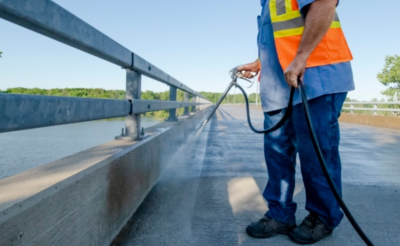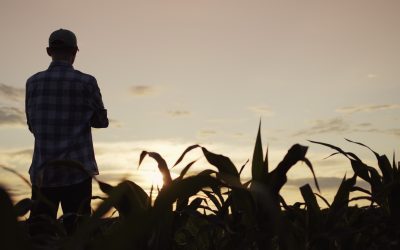M&P and ICGA sponsor Sen. Braun’s farm bill roundtable
The Indiana Corn Growers Association (ICGA) and the Indiana Soybean Alliance Membership & Policy Committee (M&P) sponsored an online farm bill roundtable for Sen. Mike Braun (R-Ind.) on Aug. 24 on the campus of Huntington University in Huntington, Ind.
Sen. Braun is a member of the U.S. Senate Ag Committee. He said he is seeking farmers’ views on what they want to see in the next farm bill because few in Congress understand farm issues.

“First, there aren’t many on the ag committee who are associated with agriculture,” Braun explained. “Sen. Jon Tester, a Democrat from Montana, still puts out a crop. Most on the ag committee are getting briefed by their staff, who are 20 or 30 years old with no farm experience. So, you have to be careful.”
The roundtable panel included M&P board member Brian Warpup, Indiana Farm Bureau President Randy Kron, Williamson Crop Insurance owner Jason Williamson and State Rep. Dave Heine (R-Fort Wayne). WOWO Radio Farm Director Rob Winters was the emcee.
Several farmers told Braun and the roundtable panel that they want some programs from the 2018 Farm Bill, such as crop insurance, the Agricultural Risk Coverage (ARC) and Price Loss Coverage (PLC), carried over into the next farm bill. Braun indicated that he does not anticipate the present crop insurance structure to change in the 2023 Farm Bill. Williamson, who is also the Treasurer of the Crop Insurance Professionals Association, admitted he was relieved to hear that news. He added that there are always fears that good programs will get changed.

“We’re just thrilled with how crop insurance is working right now,” Williamson said. “It’s a public-private partnership. It has worked very well for the private sector to deliver to the farmers we serve. More than 90 percent of the row crops in America today are covered by some form of federal crop insurance, and we’re doing that with what in Title 11 is less than 8 percent of the farm bill funding.”
Braun said there is some concern that some federal lawmakers may try to tie specific conservation requirements to crop insurance or other farm bill programs.
Warpup, a farmer from Warren, Ind., said he gets concerned when federal lawmakers begin to negotiate for specific items. “The detachment of Washington to the common voting person or farmer, I agree can be a problem,” Warpup said. “We want crop insurance, but they attach so many other aspects to that, whether it is conservation tillage or whatever, and it becomes a problem.
“What they don’t realize is that the same practice just doesn’t work with every acre. One size does not always fit every farm, every field or every location. Even on our own farm, we don’t farm every acre the same way. So, there needs to be some flexibility in this farm bill not to tell everybody what to do. I think we need to paint the farm bill with broad strokes. It’s discouraging, anyway, to have someone in Washington, who isn’t in agriculture, telling us how we should farm our ground.”
Kron said crop insurance has become more important as input costs continue to rise. “We planted the most expensive cropthat I ever have in 38 years of farming,” he said. “To have a safety net is critical.”
Expanding rural internet service
Heine said that Indiana’s General Assembly has spent more than $350 million in the last four years to expand broadband internet service into rural areas around the state. He credited Indiana Farm Bureau in collecting statistics and developing maps of underserved areas across Indiana. Heine added that the federal government is also spending money to help with this effort.
Winters said more than $3 billion in high tech farm equipment hasn’t been purchased in recent years due to a lack of broadband internet access. “Until you get high-speed, fiber-optic internet service into every nook and cranny in this state, you’re not going to get people to move to rural areas, let alone start a business in those areas,” Braun said. “We’re going to get there, though.”
Kron said better internet access will help children’s education and improve the quality of life for people who live in rural areas.
Atrazine and EPA regulations
Winters said farmers have told him that they are concerned about long-standing crop protection tools, such as atrazine, being eliminated by federal regulations through the U.S. Environmental Protection Agency (EPA). He said atrazine is among the most-tested field chemicals, and there is no evidence that it harms the environment. Still, the EPA is focusing on regulating the herbicide.
“You can farm without it, but farmers like atrazine,” Warpup said. “It is critical in grass control in corn fields. In this environment that we’re in right now, we are not over-applying anything because it costs so much money. We want to be as efficient as we possibly can when applying crop protection. We hear claims that farmers over-apply everything, whether it is atrazine or something else. Well, I don’t do it. I don’t know any farmers who do it. It just costs too much to do that. We want it placed where it is going to do the most good. We don’t want any of it to go to waste; we don’t want any of it to end up in the water.”
Kron, Warpup and others are also concerned with potential EPA regulations coming as part of the Waters of the U.S. (WOTUS) policy.
Uncertainty in the economy
Warpup said the farm economy is both healthy and challenging. He said uncertainty is making some decision difficult in planning for the future.
“With inputs, there are no bargains to buy anything,” he reported. “The logistics to get so many of the products to the farm has been such a challenge this year. The prices are just unheard of. Now, we do have a good commodity; I’m not going to argue that. Since we have elevatored up in prices, I’m worried about the elevator down.”
Warpup said prices are recovering from COVID-19 pressure. “During COVID, we could sell corn for $2.90 (per bushel),” he said. “Now, I can sell it for more than $7. In two years, it has more than doubled. But my inputs have gone that way, as well.”
He added that farms are merely small businesses with many of the same issues to manage.
“When you’re a small business owner looking for a line of credit, your credit has more than doubled,” Warpup said. “That’s a lot of leverage for a small business owner to handle – especially for a family, small business.

“We have more than 20,000 farmers in the State of Indiana, but a lot more of a supporting cast to get this crop out to produce our food, to produce our fuel, to produce our fiber,” Warpup explained. “There is an enormous weight on all of our shoulders to not let that fail. Some of us are scared of what this next year might look like.”
The panel took questions from the audience, and Indiana State Department of Agriculture Director Bruce Kettler also spoke at the forum. The 90-minute roundtable can be watched on the ISA website at www.indianasoybean.com/roundtable.
Posted: November 2, 2022
Category: ICGA, Indiana Corn and Soybean Post - Fall 2022, ISA, News



